Verdict
The Garmin Epix Pro (Gen 2) is a great sports watch, but if you’ve already got an Epix and don’t massively care about a flashlight or hate the size of it, then there’s not a huge reason to upgrade.
Pros
- Now comes in three sizes
- Good battery in always-on mode
- Great all-round sports tracking
- Useful flashlight
Cons
- New software features rolling back to Epix
- Not huge upgrade on original Epix
- HR sensor accuracy
- Weather overlays not used in tracking
-
AMOLED display:AMOLED display provides superior contrast and image quality than standard screens. -
Up to 10 days battery lifeGarmin claims up to 10 days of battery, and up to 4 days battery in always-on mode.
Introduction
The Garmin Epix Pro (Gen 2) sees Garmin continue the trend it started with its Fenix range by adding a model of its outdoor watch with an AMOLED screen, while also offering some software and hardware upgrades on the non-Pro Epix, which launched in 2022.
The Pro now sees the Epix match the three size options of the Fenix series, adding new heart rate sensors and new metrics that want to tell you whether you can easily run up those hills and go the ultra distance.
Garmin’s also adding a feature that was previously only available on the Fenix 7X and is adding features to its already impressive mapping skills. So is the Garmin Epix Pro (Gen 2) an epic watch and is it a watch Epix owners should be envious of? Here’s our take.
Design and screen
- Now comes in three models
- AMOLED touchscreen display
- LED flashlight
The big news here is that Garmin has decided to offer the Epix Pro in the three case sizes, matching the 42mm, 47mm and 51mm offered with its most recent Fenix series watches. I had the 47mm version to test, which matches the size of the original Epix and measures in at the same 14.5mm thickness.
To complicate matters, Garmin offers the Pro in standard and sapphire editions, with the latter version getting you a sapphire crystal glass lens, titanium bezel and the crucial addition of TOPO maps. That pushes the price up by £100/$100 for those extras.
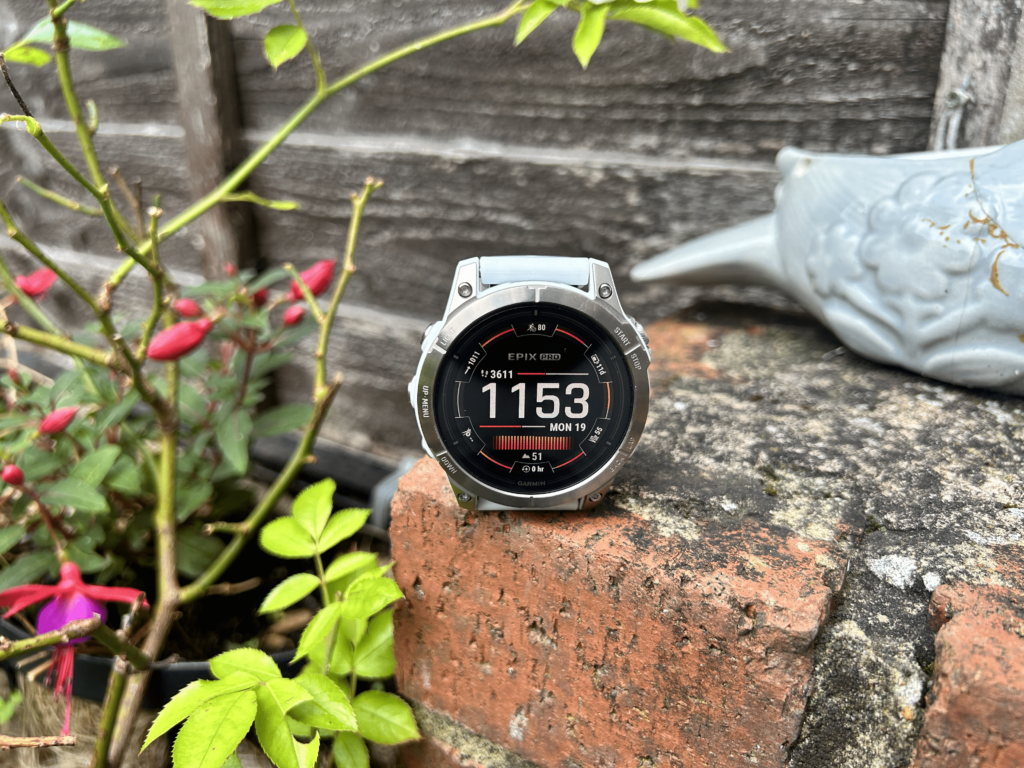
Garmin still opts against adding solar charging powers, which was absent from the original Epix as well, but does now add in an LED flashlight, which does seem a touch brighter than the one that debuted on the Fenix 7X.
The LED sits at the top of the watch case and has four white LED light brightness settings with an additional red LED flashlight mode. You can also set the flashlight to different modes including a strobe, beacon, pulse or blink and it can be set up to use while you’re in tracking mode as well.
Outside of that, this is every bit the watch we got with the original Epix. The QuickFit strap has been comfortable to wear, there’s a good array of physical buttons and while not a super light watch, it never felt like a hulking watch to wear – apart maybe from when you need to take it to bed.
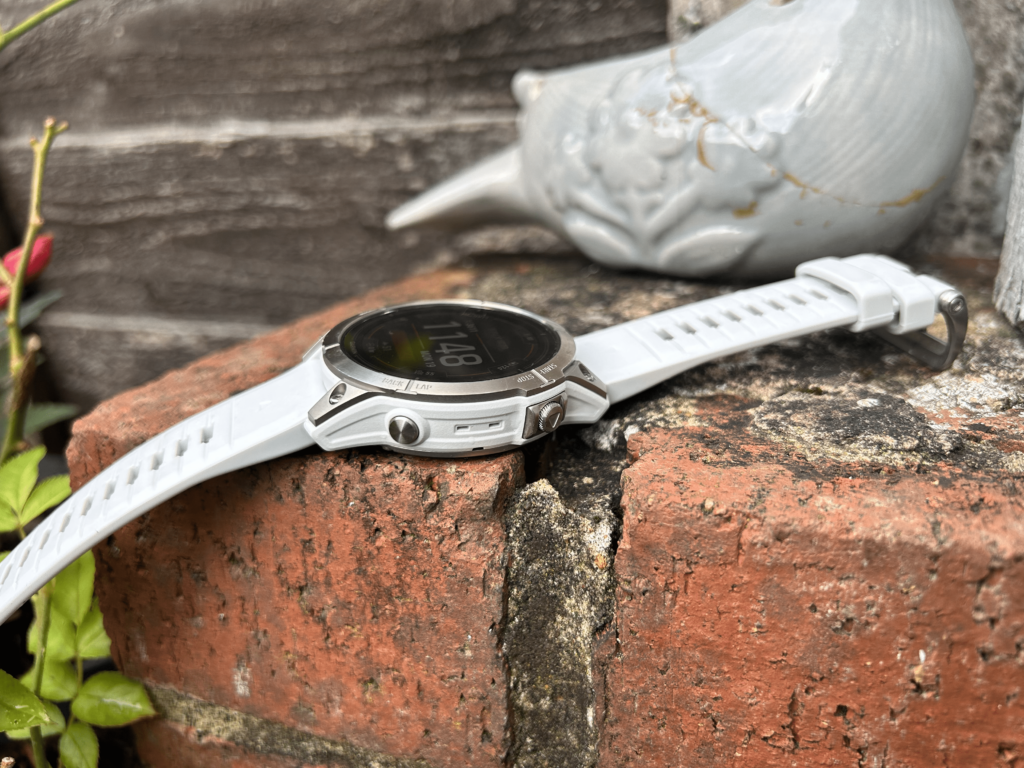
On the 47mm version, Garmin has stuck to the same 1.3-inch, 416 x 416 AMOLED touchscreen display, which is nicely responsive to touch, offers rich colours, deep blacks and has been perfectly fine to glance down at outdoors and in the water.
That water resistance rating remains the same, letting you submerge it in water up to 100 metres depth, which should be more than enough for most, unless you’re a big into your deep sea diving.
Software and smartwatch features
- Works with Android and iOS
- View and respond to notifications
- Lacks voice features from Venu 2 Plus
There’s little change in terms of what you get on the software and smartwatch front on the Garmin Epix Pro (Gen 2) compared to what we saw on the Epix.
This watch is a pretty slick performer in terms of interacting and getting around, but the sheer level of features and settings Garmin offers on watches like the Epix means you might need to play around with it a while to fully get a sense of what it’s capable of.
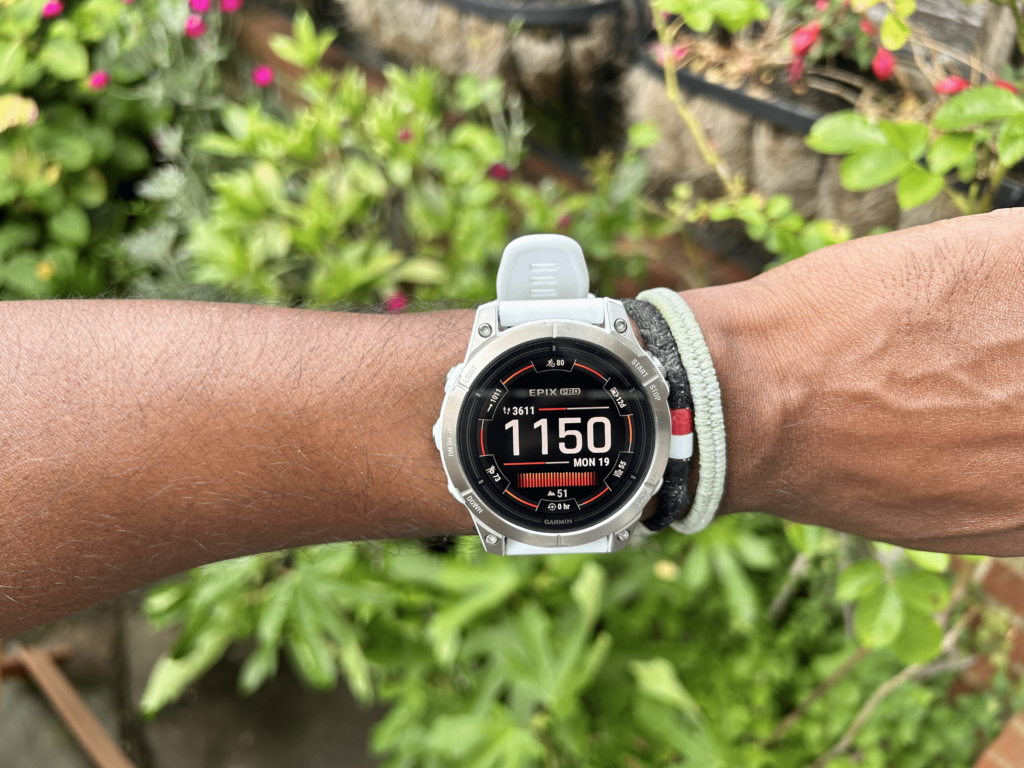
That’s especially true of new features like the flashlight and discovering its multiple modes, or enabling the red shift mode that turns the screen and interface red. It’s a similar story for the busy Garmin Connect app and the separate Connect IQ Store app that you need on your phone to add more watch faces, data fields, widgets and a small collection of apps.
That Connect IQ Store access is one of a good handful of smartwatch features you get on the Pro, which collectively doesn’t quite rival the slicker Apple Watch or Samsung Galaxy Watch. Payment support isn’t as intuitive as systems like Apple Pay while those who like the voice features on the Garmin Venu 2 Plus will be disappointed to see that functionality doesn’t make the cut.
If you like having good notification support, well integrated music controls and music player and useful features like weather updates and the Morning Report feature – which was actually a feature that grew on me over time – it does offer a better smartwatch experience than other sports watches.
Fitness tracking
- Upgraded HR sensor
- Endurance and Hill scores
- Relief shading and weather overlays on maps
The core tracking experience that you get from the Garmin Epix Pro (Gen 2) is nearly identical to the Epix Gen 2. Whether it’s tracking outdoor runs and activities with the more accurate multiband GPS or simply tracking daily steps and sleep, the Pro will serve you well.
It’s a great sports watch, it covers a large collection of activities, both indoors and outdoors, and you’ve got metrics aplenty, third-party app support and a level of training and analysis that will appeal to those who want a richer level of data.
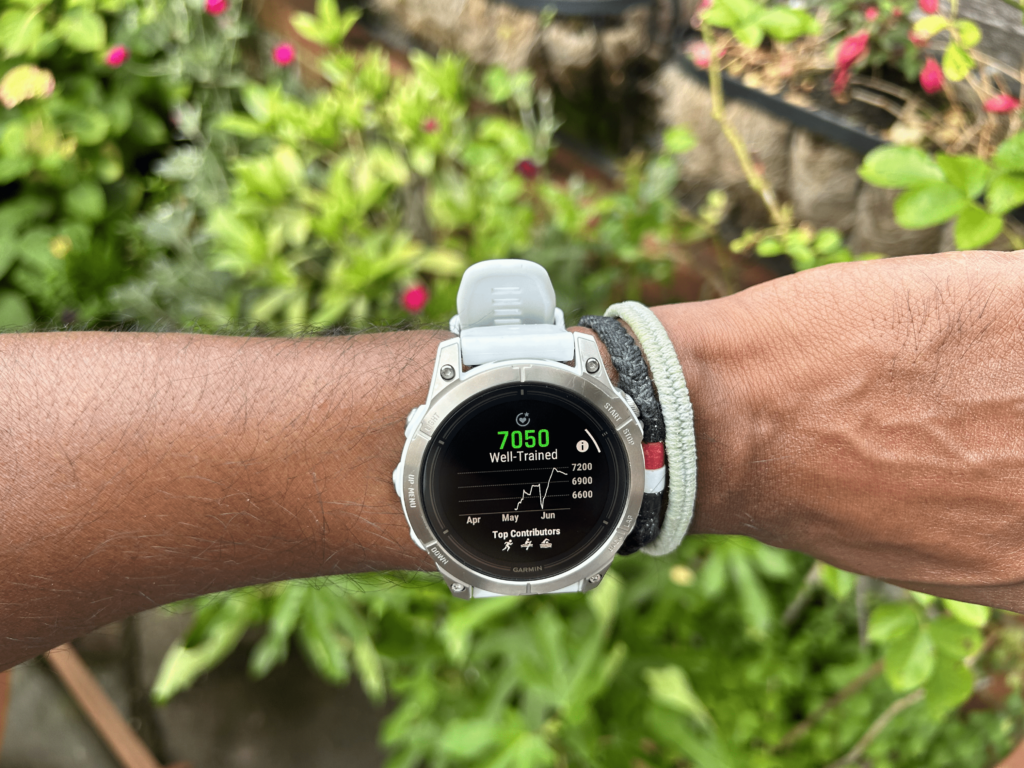
There are some new features here, some that will roll back to the older Epix and one that won’t. I’ll start with the one that won’t and that’s the new optical HR sensor, which Garmin says is built to be a better fit for tracking workouts. Optical sensors like Garmin’s one typically stutter during high-intensity exercise, so that’s what I’m really looking at here.
In practice, I’d say that the new sensor has performed well in my testing for runs and indoor workouts, but I haven’t seen enough to suggest that it’s going to be as reliable as a dedicated heart rate monitor.
It performed well in general, but I still saw the odd high spikes in data and that was against Garmin’s own HRM-Pro Plus chest strap. It’s not a huge secret that delivering heart rate from the wrist is done for convenience as opposed to delivering optimum accuracy results, and this sensor doesn’t change that. It’s pretty good, but not perfect.
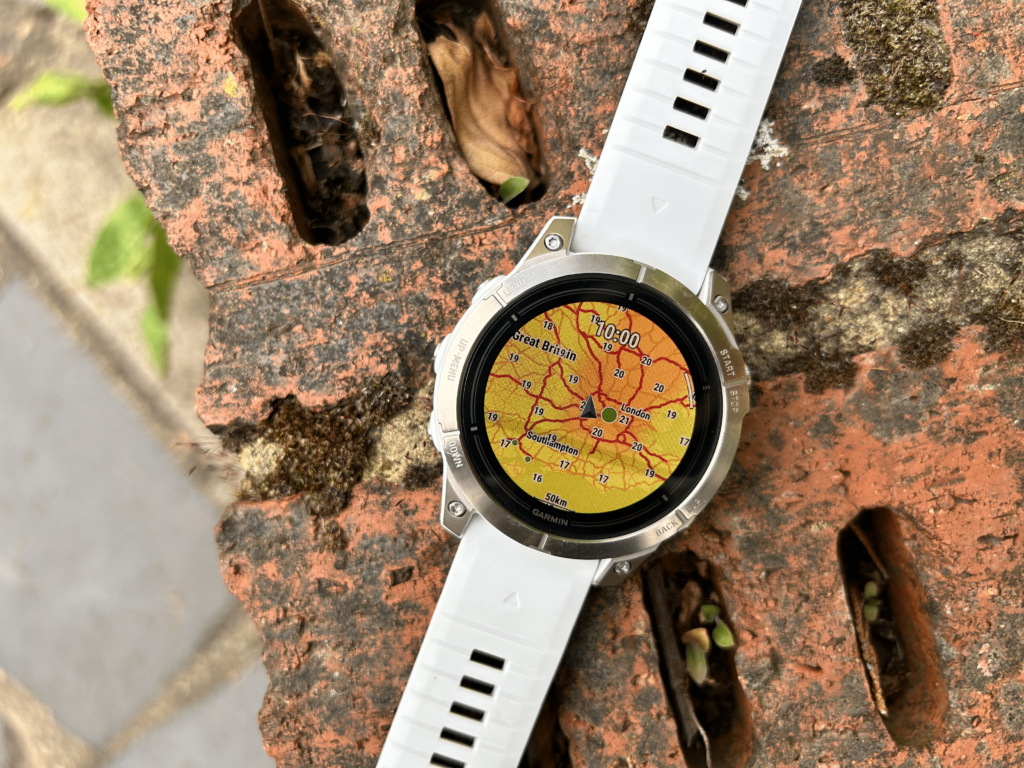
Onto the features that will come to the first Epix Gen 2 and we’re now getting new mapping features like the ability to view weather overlaid on maps like temperature, rain, and wind.
This isn’t built into the real-time tracking, however, and is instead found inside of the weather Glance (widget) outside of the workout tracking screen. Relief shading adds richer detail for navigating off-road terrain to make Garmin’s already great mapping support even better-looking on that AMOLED screen.
There’s two big metrics added into the mix with Hill Scores and Endurance Scores. Both take a few weeks to start delivering those scores, and how useful they are really depends on how much you care about tackling hills or getting a clearer idea of your endurance levels.
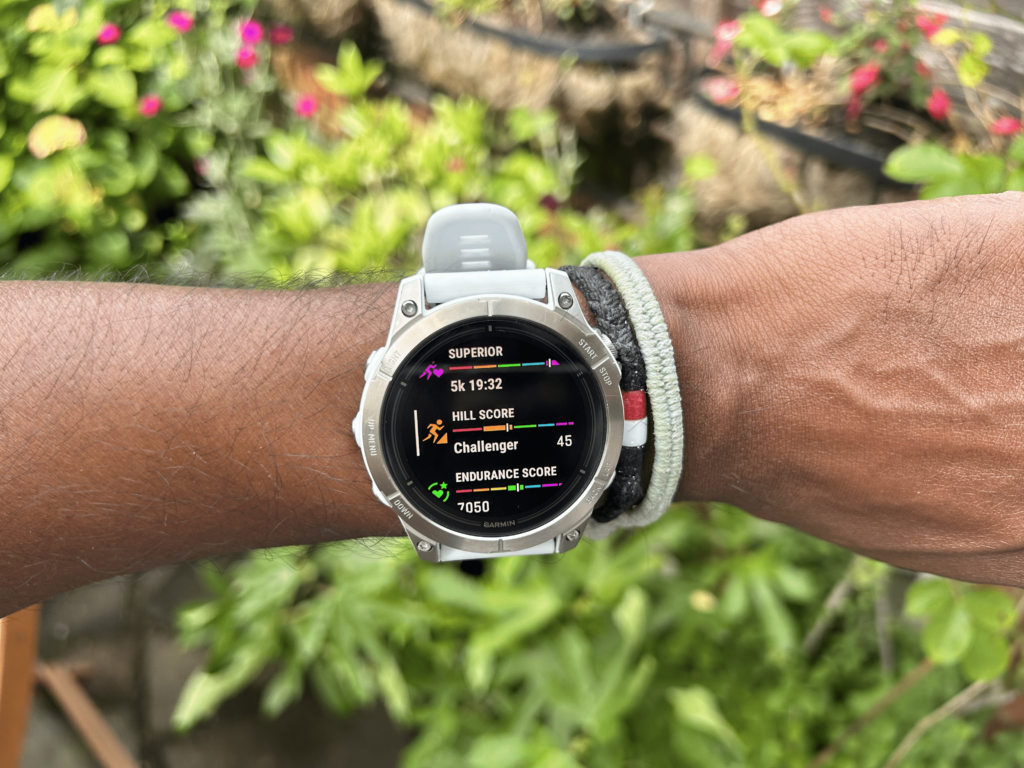
Hill scores want to help you improve your hill running, hiking or walking abilities so it analyses activities with a gradient of 2% or more, and also looks at historical data to help generate those scores. I’ve just been building up my training again and have been tagged with a 45 score out of 100, with the advice that adding more hills to training will help improve the ability to tackle hills. There’s a further breakdown of hill strength, hill endurance and Vo2 Max scores, which contribute to that overall score taking a similar approach to Garmin’s Training Readiness where you can take the simple main score or drill deeper.
Next is Endurance scores and it’s a pretty self explanatory one. This is a score that wants to give you a number to indicate just how well tuned you are to maintain effort over long periods. VO2 Max is generally the barometer for this, and Garmin uses that metric and then looks at your workout history both short term and long term (3 months) to understand if you’re building a good endurance base.
I’ve been building my training time after injury and can see quite clearly in the Endurance Score widget that my status is improving, indicating my long-distance running ability has improved.
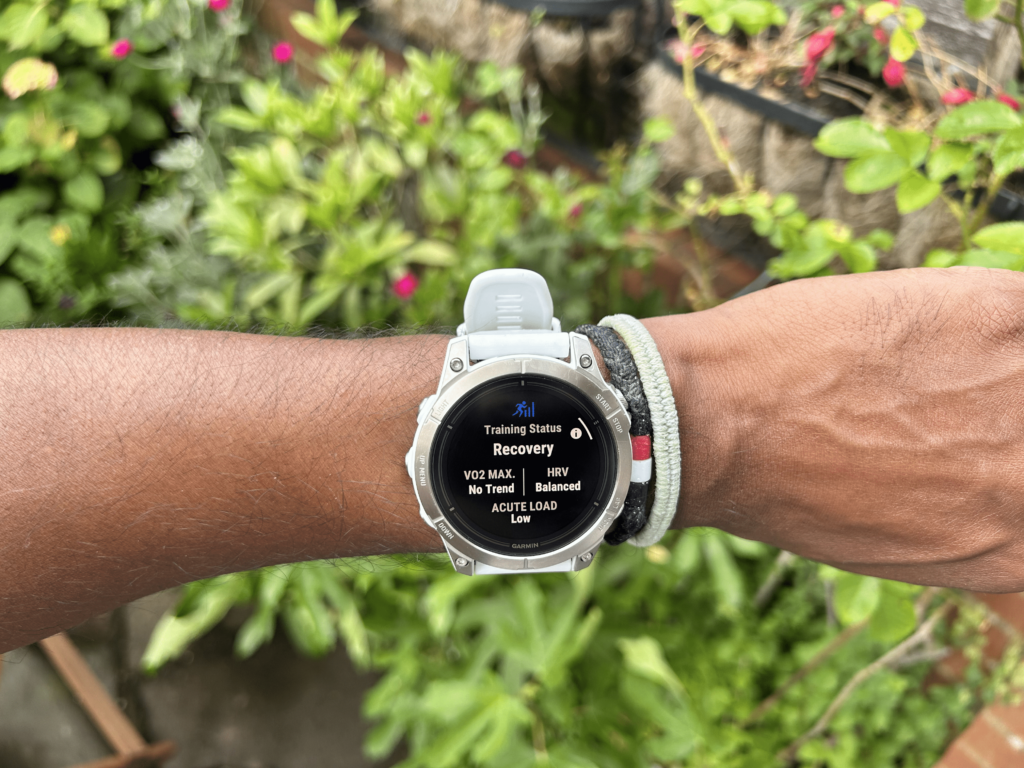
What Garmin is aiming to do, along with all the other features it offers, is to package up existing metrics and insights in a more digestible way. So if you care about if your endurance levels are improving or dropping off or you’re doing enough hill work to tackle an upcoming hilly race course, these could be useful metrics for you.
Battery life
- Up to 16 days in smartwatch mode
- Up to 6 days in always-on mode
- Up to 20 hours in top multiband GPS mode
Garmin’s move to add AMOLED screens to its watches has seen the battery life suffer, but it’s not suffered as badly as many may have anticipated. It managed to successfully add in more power-hungry display technology, and still offer strong battery performance with or without that screen set to always-on.
The numbers haven’t actually changed for the 47mm Epix Pro compared to the non-Pro Epix. It’s up to 16 days in smartwatch mode, which drops to 6 days in always-on mode. If you’re using the GPS tracking only, then it’s still the same 42 hours, while using the more accurate multiband GPS mode sees tracking battery drop to 20 hours.
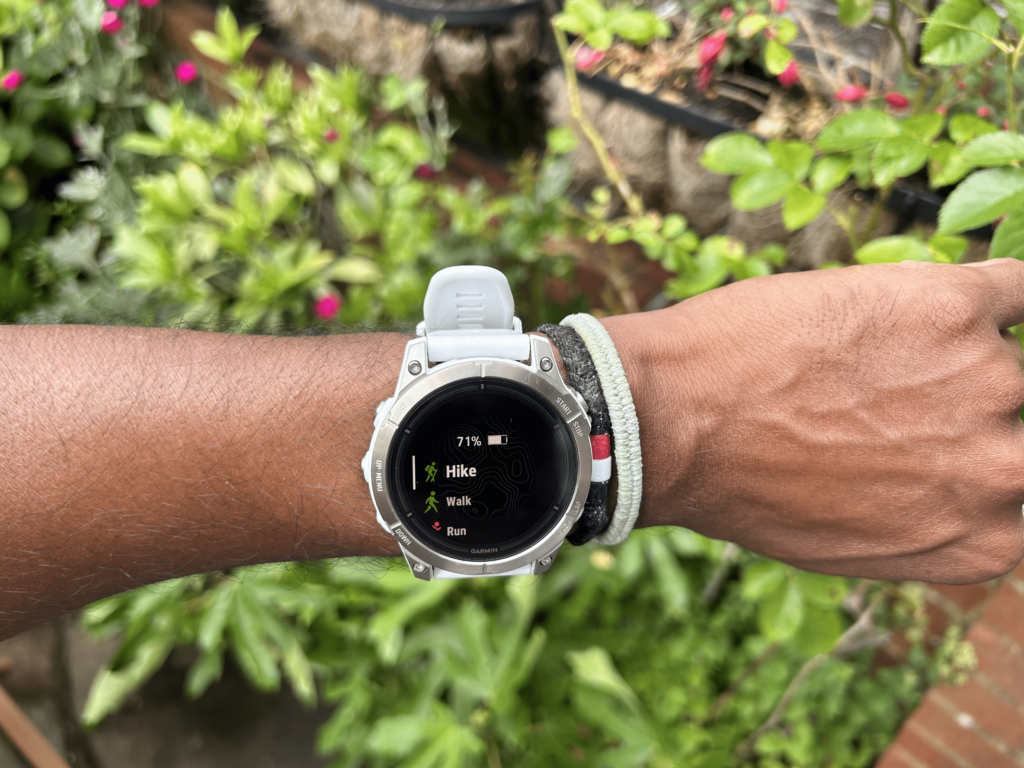
It’s the bigger 51mm Epix Pro that sees the biggest battery gains, where the 47mm Epix Pro offers much the same as the Epix. With the screen set to always-on I saw a daily drop-off of 10%. With added tracking that will of course be bigger, but the battery still holds strong.
With the screen set to always-on for just under two hours of tracking in the top multiband mode, the battery dropped by 10%.
If you choose to rely on the raise to wake instead of the AOD mode, you will get longer, but even with it enabled the battery on the Epix Pro battery is still very impressive.
Latest deals
Should you buy it?
You want an AMOLED Garmin watch with great battery:
Like the Epix, the Epix Pro can still dish out great battery. Especially if you opt for the biggest 51mm version.
You have the non-Pro Epix:
You might not get an LED flashlight or more size options, but features like Hill and Endurance scores and new mapping smarts will be heading to the Epix Gen 2 as well.
Final Thoughts
The Garmin Epix Pro (Gen 2) feels like yet another move by Garmin to cover all the pricing bases and to ward off the Apple Watch Ultra competition. Is it a strong-performing sports watch? Absolutely. Does it need to exist? Probably not, but it gives those looking for a sports watch with the feel of a smartwatch more options to choose from.
Check out our best smartwatch and best running watch lists for even more options.
How we test
We thoroughly test every fitness watch/tracker we review. We use industry standard testing to compare features properly and we use the watch as our main device over the review period. We’ll always tell you what we find and we never, ever, accept money to review a product.
Compared against rival devices
Worn as our main tracker during the testing period
FAQs
No, the Garmin Epix Pro doesn’t include the PowerGlass lens that Garmin includes on its Fenix watches to enable solar charging.
Yes, the Garmin Epix Pro does include an LED flashlight, which offers white and red LED light options.
Verdict
The Garmin Epix Pro (Gen 2) is a great sports watch, but if you’ve already got an Epix and don’t massively care about a flashlight or hate the size of it, then there’s not a huge reason to upgrade.
Pros
- Now comes in three sizes
- Good battery in always-on mode
- Great all-round sports tracking
- Useful flashlight
Cons
- New software features rolling back to Epix
- Not huge upgrade on original Epix
- HR sensor accuracy
- Weather overlays not used in tracking
-
AMOLED display:AMOLED display provides superior contrast and image quality than standard screens. -
Up to 10 days battery lifeGarmin claims up to 10 days of battery, and up to 4 days battery in always-on mode.
Introduction
The Garmin Epix Pro (Gen 2) sees Garmin continue the trend it started with its Fenix range by adding a model of its outdoor watch with an AMOLED screen, while also offering some software and hardware upgrades on the non-Pro Epix, which launched in 2022.
The Pro now sees the Epix match the three size options of the Fenix series, adding new heart rate sensors and new metrics that want to tell you whether you can easily run up those hills and go the ultra distance.
Garmin’s also adding a feature that was previously only available on the Fenix 7X and is adding features to its already impressive mapping skills. So is the Garmin Epix Pro (Gen 2) an epic watch and is it a watch Epix owners should be envious of? Here’s our take.
Design and screen
- Now comes in three models
- AMOLED touchscreen display
- LED flashlight
The big news here is that Garmin has decided to offer the Epix Pro in the three case sizes, matching the 42mm, 47mm and 51mm offered with its most recent Fenix series watches. I had the 47mm version to test, which matches the size of the original Epix and measures in at the same 14.5mm thickness.
To complicate matters, Garmin offers the Pro in standard and sapphire editions, with the latter version getting you a sapphire crystal glass lens, titanium bezel and the crucial addition of TOPO maps. That pushes the price up by £100/$100 for those extras.

Garmin still opts against adding solar charging powers, which was absent from the original Epix as well, but does now add in an LED flashlight, which does seem a touch brighter than the one that debuted on the Fenix 7X.
The LED sits at the top of the watch case and has four white LED light brightness settings with an additional red LED flashlight mode. You can also set the flashlight to different modes including a strobe, beacon, pulse or blink and it can be set up to use while you’re in tracking mode as well.
Outside of that, this is every bit the watch we got with the original Epix. The QuickFit strap has been comfortable to wear, there’s a good array of physical buttons and while not a super light watch, it never felt like a hulking watch to wear – apart maybe from when you need to take it to bed.

On the 47mm version, Garmin has stuck to the same 1.3-inch, 416 x 416 AMOLED touchscreen display, which is nicely responsive to touch, offers rich colours, deep blacks and has been perfectly fine to glance down at outdoors and in the water.
That water resistance rating remains the same, letting you submerge it in water up to 100 metres depth, which should be more than enough for most, unless you’re a big into your deep sea diving.
Software and smartwatch features
- Works with Android and iOS
- View and respond to notifications
- Lacks voice features from Venu 2 Plus
There’s little change in terms of what you get on the software and smartwatch front on the Garmin Epix Pro (Gen 2) compared to what we saw on the Epix.
This watch is a pretty slick performer in terms of interacting and getting around, but the sheer level of features and settings Garmin offers on watches like the Epix means you might need to play around with it a while to fully get a sense of what it’s capable of.

That’s especially true of new features like the flashlight and discovering its multiple modes, or enabling the red shift mode that turns the screen and interface red. It’s a similar story for the busy Garmin Connect app and the separate Connect IQ Store app that you need on your phone to add more watch faces, data fields, widgets and a small collection of apps.
That Connect IQ Store access is one of a good handful of smartwatch features you get on the Pro, which collectively doesn’t quite rival the slicker Apple Watch or Samsung Galaxy Watch. Payment support isn’t as intuitive as systems like Apple Pay while those who like the voice features on the Garmin Venu 2 Plus will be disappointed to see that functionality doesn’t make the cut.
If you like having good notification support, well integrated music controls and music player and useful features like weather updates and the Morning Report feature – which was actually a feature that grew on me over time – it does offer a better smartwatch experience than other sports watches.
Fitness tracking
- Upgraded HR sensor
- Endurance and Hill scores
- Relief shading and weather overlays on maps
The core tracking experience that you get from the Garmin Epix Pro (Gen 2) is nearly identical to the Epix Gen 2. Whether it’s tracking outdoor runs and activities with the more accurate multiband GPS or simply tracking daily steps and sleep, the Pro will serve you well.
It’s a great sports watch, it covers a large collection of activities, both indoors and outdoors, and you’ve got metrics aplenty, third-party app support and a level of training and analysis that will appeal to those who want a richer level of data.

There are some new features here, some that will roll back to the older Epix and one that won’t. I’ll start with the one that won’t and that’s the new optical HR sensor, which Garmin says is built to be a better fit for tracking workouts. Optical sensors like Garmin’s one typically stutter during high-intensity exercise, so that’s what I’m really looking at here.
In practice, I’d say that the new sensor has performed well in my testing for runs and indoor workouts, but I haven’t seen enough to suggest that it’s going to be as reliable as a dedicated heart rate monitor.
It performed well in general, but I still saw the odd high spikes in data and that was against Garmin’s own HRM-Pro Plus chest strap. It’s not a huge secret that delivering heart rate from the wrist is done for convenience as opposed to delivering optimum accuracy results, and this sensor doesn’t change that. It’s pretty good, but not perfect.

Onto the features that will come to the first Epix Gen 2 and we’re now getting new mapping features like the ability to view weather overlaid on maps like temperature, rain, and wind.
This isn’t built into the real-time tracking, however, and is instead found inside of the weather Glance (widget) outside of the workout tracking screen. Relief shading adds richer detail for navigating off-road terrain to make Garmin’s already great mapping support even better-looking on that AMOLED screen.
There’s two big metrics added into the mix with Hill Scores and Endurance Scores. Both take a few weeks to start delivering those scores, and how useful they are really depends on how much you care about tackling hills or getting a clearer idea of your endurance levels.

Hill scores want to help you improve your hill running, hiking or walking abilities so it analyses activities with a gradient of 2% or more, and also looks at historical data to help generate those scores. I’ve just been building up my training again and have been tagged with a 45 score out of 100, with the advice that adding more hills to training will help improve the ability to tackle hills. There’s a further breakdown of hill strength, hill endurance and Vo2 Max scores, which contribute to that overall score taking a similar approach to Garmin’s Training Readiness where you can take the simple main score or drill deeper.
Next is Endurance scores and it’s a pretty self explanatory one. This is a score that wants to give you a number to indicate just how well tuned you are to maintain effort over long periods. VO2 Max is generally the barometer for this, and Garmin uses that metric and then looks at your workout history both short term and long term (3 months) to understand if you’re building a good endurance base.
I’ve been building my training time after injury and can see quite clearly in the Endurance Score widget that my status is improving, indicating my long-distance running ability has improved.

What Garmin is aiming to do, along with all the other features it offers, is to package up existing metrics and insights in a more digestible way. So if you care about if your endurance levels are improving or dropping off or you’re doing enough hill work to tackle an upcoming hilly race course, these could be useful metrics for you.
Battery life
- Up to 16 days in smartwatch mode
- Up to 6 days in always-on mode
- Up to 20 hours in top multiband GPS mode
Garmin’s move to add AMOLED screens to its watches has seen the battery life suffer, but it’s not suffered as badly as many may have anticipated. It managed to successfully add in more power-hungry display technology, and still offer strong battery performance with or without that screen set to always-on.
The numbers haven’t actually changed for the 47mm Epix Pro compared to the non-Pro Epix. It’s up to 16 days in smartwatch mode, which drops to 6 days in always-on mode. If you’re using the GPS tracking only, then it’s still the same 42 hours, while using the more accurate multiband GPS mode sees tracking battery drop to 20 hours.

It’s the bigger 51mm Epix Pro that sees the biggest battery gains, where the 47mm Epix Pro offers much the same as the Epix. With the screen set to always-on I saw a daily drop-off of 10%. With added tracking that will of course be bigger, but the battery still holds strong.
With the screen set to always-on for just under two hours of tracking in the top multiband mode, the battery dropped by 10%.
If you choose to rely on the raise to wake instead of the AOD mode, you will get longer, but even with it enabled the battery on the Epix Pro battery is still very impressive.
Latest deals
Should you buy it?
You want an AMOLED Garmin watch with great battery:
Like the Epix, the Epix Pro can still dish out great battery. Especially if you opt for the biggest 51mm version.
You have the non-Pro Epix:
You might not get an LED flashlight or more size options, but features like Hill and Endurance scores and new mapping smarts will be heading to the Epix Gen 2 as well.
Final Thoughts
The Garmin Epix Pro (Gen 2) feels like yet another move by Garmin to cover all the pricing bases and to ward off the Apple Watch Ultra competition. Is it a strong-performing sports watch? Absolutely. Does it need to exist? Probably not, but it gives those looking for a sports watch with the feel of a smartwatch more options to choose from.
Check out our best smartwatch and best running watch lists for even more options.
How we test
We thoroughly test every fitness watch/tracker we review. We use industry standard testing to compare features properly and we use the watch as our main device over the review period. We’ll always tell you what we find and we never, ever, accept money to review a product.
Compared against rival devices
Worn as our main tracker during the testing period
FAQs
No, the Garmin Epix Pro doesn’t include the PowerGlass lens that Garmin includes on its Fenix watches to enable solar charging.
Yes, the Garmin Epix Pro does include an LED flashlight, which offers white and red LED light options.

























